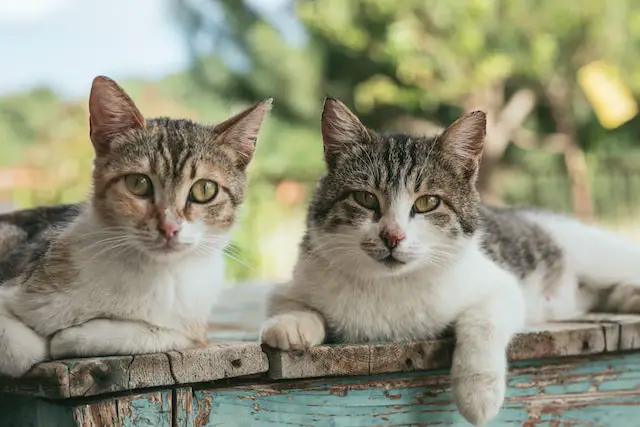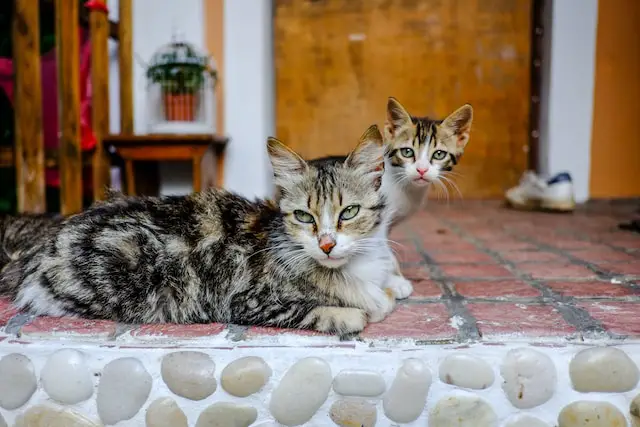Ireland has a serious cat problem. The ISPCA estimates there to be more than 200,000 feral cats living in colonies all over Ireland. It is also estimated that one unspayed female cat can have roughly 18 kittens in just one year. Within five years, that female cat can be responsible for 20,000 descendants.
A large number of these kittens die before they are 4 months old. The best prevention is to spay and neuter but how do we do this for feral cats who are afraid of people? The solution is referred to by animal rescues as Trap Neuter Return.

Trap neuter return, or TNR, is a method of humanely trapping feral cats, spaying or neutering them, and releasing them back to the same location where they were collected. Spaying and neutering can help the colony stay healthier. Diseases such as feline AIDS and leukemia spread between feral cats and unneutered males are more likely to fight and spread even more disease.
Trap neuter return begins with the trapping of feral cats. The captured cats are taken in the trap to a vets where they are sterilised by the neutering of males and spaying of females. Often the cats will also be ear tipped. The procedure involves removing approximately a quarter-inch off the tip of the cat's left ear in a straight line cut. Eartipping is the universal sign of a neutered or spayed feral cat. This is done while the cat's anaesthetised and healing is rapid. It prevents the same cat being picked up twice.
TNR is not seen by everyone as the best solution to the problem of managing feral cat populations. This is seen especially in areas where cats are an invasive species and the feral cats inflict death to the wildlife in the area. Wildlife groups support the adoption into domestic settings or the humane euthanasia of animals that cannot be rehabilitated and re-homed
What is the difference between a feral cat and a stray cat
A feral cat is a cat that has never had human contact and is fearful of humans while a stray cat is a once domesticated cat, either lost or abandoned.
A feral cat usually starts off as the offspring of an unspayed domestic cat that has strayed. There are many ways a cat can stray, it can become lost after travelling too far from home, their owner may have passed away or they may be abandoned by their owners. Because their kittens will not have human contact they will be afraid of people in some cases. If the kittens are caught early they can be tamed and become domesticated. To avoid this happening cat owners should have their pets spayed and neutered.
Both with the assistance of local rescues and help from my family I have completed successful TNR numerous times and will now break down the instructions step by step.
Step 1: Assess the situation
The first part of the plan is to find out exactly what you are dealing with. Is it one cat or 20? Both situations would be dealt with differently but with equal urgency as that one cat can turn to 20 very fast.
Step 2: Speak to your vet and start a set feeding routing
Pick a time of day when it would be most suitable to trap the cat and start to feed the cat at this time every day. When picking the time, confirm with the vets that they can take a trapped cat around this time as you will want to be able to drive it to the vets as soon as it is caught.
Step 3: Locate a trap and figure out costs
Depending on how comfortable the cats are with you there is a chance you could catch them in a regular cat carrier. I have managed this before but the cats had been fed daily by us for a year at this point. And for one of them I am still surprised we managed to catch her this way so expect some element of luck if you manage it. The other option is a cat trap. I have used these with great success for cats I was less familiar with. They are available on loan from rescues. Not all will loan their traps as they are expensive to purchase. They will usually ask for a deposit or a donation for the use of one. There may also be a waiting list for people looking to get one.
There are some cat traps avilable on amazon. I have not used one from here so if considering buying one do your research before purchasing. Ensure they are large enough for a cat to go into comfortably.
When preparing for TNR speak to your vets about costs as spaying and neutering is not cheap. Some rescues do offer vouchers to help cover some of the costs of this but it varies from county to county. The majority if not all vets expect payment up front for services and won’t do a payment plan. If there is a large feral cat population that you are helping consider doing a fundraiser to get the money to spay and neuter the entire colony.
Cats are not treated in the same way as dogs in Ireland. There is no cat warden to pick up strays. If you get assistance from a local rescue with the costs, consider volunteering or donating at a future date when you can afford to. This will allow them to continue to help others with feral cats.

Step 4: Plan the day of attack!
Once you have gained some trust with the cats and they are used to their feeding routine and figured out a trap, now is the time to book the appointment with the vets. You will need transportation on the day too so this will also need to be arranged at this time if you do not have access to your own.
You will also need blankets or towels to cover the trap once the cat is inside. Our vets would take the cats in the evening so after trapping we drove them straight there. Some cats may soil themselves during the journey so place something under the carrier just in case.
Step 5: Time to Trap
Finally the day is here. I have seen it recommended not to feed the cats the day before, or feed them only a small amount, this is to ensure they are hungry on the day of catching so will definitely go into the trap. We didn’t use this method, instead we used very smelly fish that they couldn’t resist. But you will have to decide a method based on how trusting the cats are of you.
Place the trap down quickly and walk away. Cats are very aware of our changes in body language. Even my own pet cat knows when I am trying to catch him to give him medicine before I have even turned to walk towards him. If you are using a cat carrier you will need to be close enough to close the door once the cat is inside but keep as far back as possible. A few practice runs to ensure you can close the lock quickly would be no harm.
Next we wait! It’s impossible to know how long it might take for them to fall for your trap. Make sure to allow a decent amount of time to wait for the cat to get into the trap and still allow you to make it in time to drop off at the vets.
Step 6: Success - the cat is caught
The cat is in the trap! After possibly weeks of planning there is nothing more satisfying than finally getting that cat into the trap. Place the trap in the car and cover it with a blanket or towel.
The cat will be frightened at this stage so drive it to the vets as soon as possible.
Step 7: Recovery
The cat will usually be ready to go home the next day after its surgery. It is best to monitor them closely for a few days after treatment. If you have somewhere to hold them for a day or two then great but I have never managed to do this. We did try with one of the more friendly ferals but she panicked and managed to escape so we felt it less stressful for them to release instead. We always waited until it was warm out before having it done. We released them back to the colony when home from the vets. All but one of the cats returned to normal when we did this. One was not impressed with us and stayed a further distance from us for about two weeks after. Thankfully we could still see her and we allowed her to recover by putting her food further from the house.
Step 8: Repeat for every cat in the colony
This is probably the most important part. Keep going! It is amazing the difference in a colony once all the cats are spayed and neutered. When we started the process at my parents house there were 13 cats sitting at their back door every day shouting for food. The most feral kittens had infected eyes and were so hard to catch to give treatment. We got to work and got all of them sorted. Now 15 years later only one of the original 13 remains and she is a very happy cat. She is showing no signs of illness even at 17 years of age.
I don’t want cats. What happens if I don’t want them returned?
This is a harder problem to solve. You are overrun with cats but have no interest in becoming a caregiver for a colony! The first step is still Trap Neuter Return. Getting the population under control is even more important if you aren’t a fan of cats. They aren’t just going to go away.
The sad truth is that rescues are full. There are far more cats than the rescues can ever manage so the chances of someone being able to come and take all the cats immediately is slim.
Contact the rescue and explain the situation. Some rescues will have volunteers who do the trapping and may be able to help with this first. Rescues also advertise farm/feral cats available for adoption. As these cats are not used to human contact it is not nice for them to have to spend them in a shelter, if there was even space to begin with, so if they do find a home it is best they go straight from their first location to the new one. Contact your local rescues for further advice.
I want to keep them, how do I care for a colony of feral cats?
Daily feeding is required for the colony. Place the food in bowls and remove any leftover food to avoid rats or mice. It is also important to always have a source of clean water available.
If there is no shed or other shelter available then it is best to provide one. This will definitely be needed for the winter months. A small kennel or plastic container with an entrance hole cut in the front would make a good shelter. Ensure it is in a shaded area if possible away from direct wind and rain. Straw is the best material to fill it with. Do not use hay as this will soak up the moisture.
Keep an eye on the general health of the colony. I have found once spayed and neutered the colony remains healthier with minimal interference. Ask your vets about ways to give the cats flea and worm treatments and keep a cat box on hand in case you do need to take a sick cat to the vets. Overall, being a caregiver to a colony of cats is a great experience once TNR is completed.
